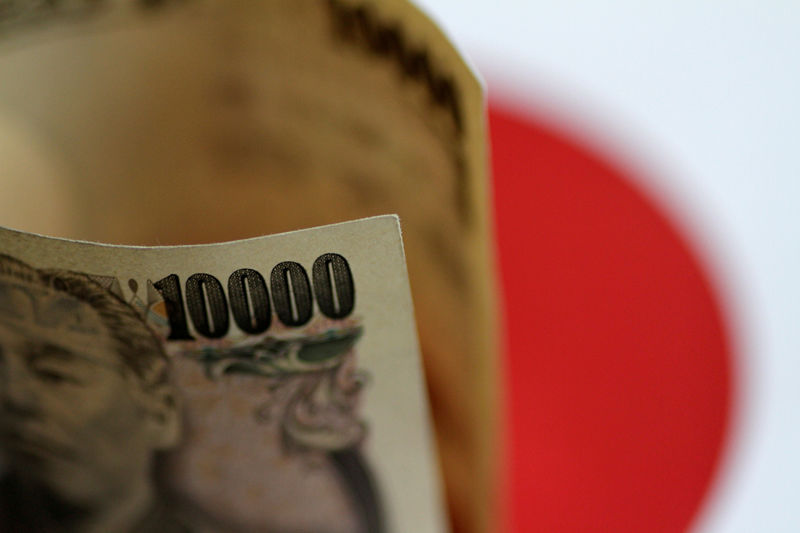By Gertrude Chavez-Dreyfuss
NEW YORK (Reuters) -The yen fell to multi-year lows against the U.S. dollar and euro on Tuesday, leaving investors keenly watching Japanese intervention ahead of this week’s Bank of Japan policy meeting.
The euro reached 165.71 yen, its highest level since 2008, after data showed euro zone business activity grew at the fastest pace in almost a year, mainly due to a recovery in the services sector. Europe’s common currency last rose 0.4% to 165.67 yen.
The dollar rose to 154.88 against the yen, a 34-year high and closer to 155, a level seen by market participants as the new trigger for Japanese intervention.
The greenback was last little changed on the day at 154.79 yen.
“The 155 level for the dollar/yen is a key psychological figure after Japanese officials failed to intervene on behalf of their currency at 152,” said Helen Given, currency trader at Monex USA in Washington.
“While (BOJ Governor Kazuo) Ueda has said several times that the BOJ will not raise rates just to boost the yen, there is a lot of potential for action from currency officials in conjunction with Friday’s meeting.”
She added that the BOJ is likely to hold firm on Friday, which could mean further yen weakness, but thinks “there is a fairly good chance that we see market intervention that same evening to prevent a bigger decline towards 160.” “
Earlier on Tuesday, Japanese Finance Minister Shunichi Suzuki issued his strongest warning yet about the likelihood of intervention. He said last week’s meeting with his US and South Korean counterparts laid the groundwork for Tokyo to act against excessive yen movements.
Remove ads
.
However, there were doubts whether Tokyo would take action so close to the BOJ’s two-day policy meeting that starts on Thursday.
Japan’s central bank is expected to forecast inflation will remain around its 2% target over the next three years, according to a new estimate published on Friday. This indicates that it is prepared to cautiously raise interest rates again this year from a level of almost zero.
The dollar fell slightly against the yen after data showed U.S. business activity fell to a four-month low in April amid weaker demand.
S&P Global said Tuesday that the flash US Composite PMI Output Index, which tracks both manufacturing and services sectors, fell to 50.9 from 52.1 in March, a level slightly above expansion territory.
Yields also fell after the PMI data, down 0.4% to 105.66. It fell to a two-week low of 105.61.
The euro, meanwhile, climbed to a two-week peak against the dollar of $1.0711 before drifting back to $1.0707, up 0.5%.
The single currency also briefly equaled the previous day’s three-month high against the pound of 86.43 pence, following German PMI data. The euro last fell 0.3% to 85.95 pence.
The Bank of England’s dovish policy comments left sterling near its weakest level in months. BOE officials said they expect inflation to slow toward the 2% target and likely stay there, giving investors confidence that the bank will cut rates in the summer.
Earlier this year, the pound was lifted on expectations that the BoE would cut rates significantly later than the European Central Bank, which currently sees markets easing in June.
Remove ads
.
The British currency had fallen to a five-month low of $1.2299 against the dollar on Monday, but recovered to $1.2450 on Tuesday, up 0.8% in the wake of strong UK business activity data.
In the United States, investors expect the Federal Reserve to be among the last major central banks to cut, with the interest rate futures market currently pricing in a 73% chance of an initial easing in September, according to the CME’s FedWatch tool.
That was in stark contrast to a few weeks ago, when markets were betting that the Fed’s easing cycle would begin in June, a shift that has pushed the dollar higher.
Investors will have another chance to assess the strength of the US economy this week, with first-quarter gross domestic product data on Thursday and the PCE index, the Fed’s preferred inflation measure, on Friday .
Market players expect a 0.3% increase in the overall PCE figure in March, unchanged from the previous month, and a year-on-year increase of 2.6%, compared to a 2.5% increase in February, according to a Reuters poll.


